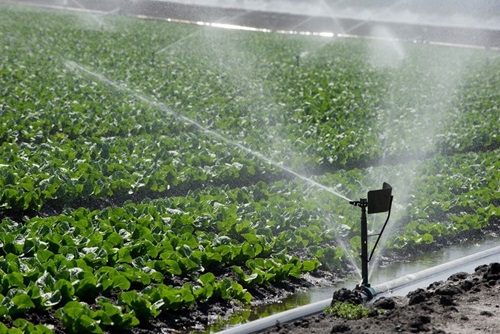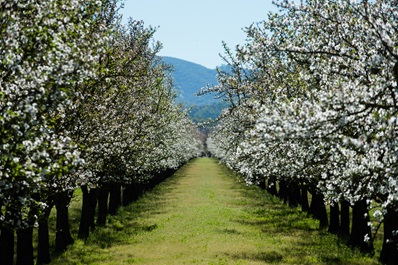Agriculture

Water irrigation on a lettuce farm in Monterey County. DWR/2013.
Agriculture is the practice and science of cultivating soil for growing crops to provide food, fiber, and other commodities and products for people to purchase and consume. Thanks to a unique geography and a dry climate that provides an almost year-round growing season, California is the nation’s leading farm state and one of the world’s largest producers of food and fiber.
California’s conditions are favorable for the production of a multitude of crops and more than 400 commodities, including almonds, walnuts, lettuce, tomatoes, strawberries, and grapes.
California’s agricultural success can be attributed to irrigation, the act of supplementing rainfall during times of no precipitation to meet the water demands of plants.
On average, California agriculture irrigates more than 9 million acres using roughly 34 million acre-feet of water typically diverted from surface waters – rivers, lakes, and reservoirs that deliver water through an extensive network of aqueducts and canals – or pumped from groundwater.
Applying the right amount of water at the right time not only ensures agricultural crops’ growth, but also aids in conserving the state’s limited water supply. Our Water Use Efficiency Branch runs the California Irrigation Management Information System (CIMIS), an integrated network of 145 automated weather stations located throughout California. CIMIS supplies data to the public and growers to determine when to irrigate and how much water to apply.

The State Water Project allocates water based on water year; agricultural crops also receive water supply through the federal Central Valley Project.
Irrigation districts and water agencies play a role in distributing irrigation water, which includes obtaining and maintaining legal rights to the water, and wielding the water to meet the irrigation demands of its members. Water purveyors are involved in long-term planning for water supply; development and maintenance of the delivery infrastructure; regular billing of their members; helping members meet water conservation goals; and assisting with wildlife habitat and water quality outflow requirements.
New developments in technology and water management strategies coupled with increased public awareness have led to more efficient agricultural water use, which also saves energy and reduces costs.
